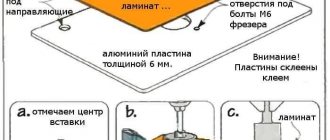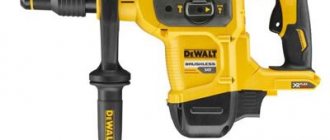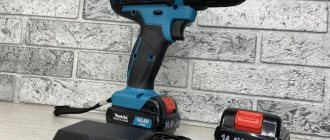What is a hammer drill and what work is it intended for?
A hammer drill is an electrical device that is used to drill holes in concrete and brick. It has more power and functionality than any impact drill and will help you cope with construction and repair tasks much easier and faster. With it you can:
- lay wires making grooves;
- drill walls for installation of sockets and switches;
- fix windows, doors, profiles;
- dismantle floors and tiles;
- install plinth;
- install a lock;
- mix solutions, putty, glue.
A modern hammer drill is a universal multifunctional device, thanks to which you can perform a large number of different jobs quickly and efficiently.
The operating principle of rotary hammers, their advantages, operations performed
The operating principle of rotary hammers is simple. Gouging out holes occurs through a combination of impact-translational and rotational movements of the drill. It does not cut the material with sharp edges, but pierces it. Therefore, the devices are sharpened accordingly.
Photo No. 2: drill bits for rotary hammers
How do rotary hammers differ from impact drills?
Rotary hammers differ from impact drills in their impact technology. For the latter, it is created through the operation of a ratchet mechanism. This determines the following differences between the instruments.
| Parameter | Hammer | Hammer drill |
| Penetration speed into solid materials | High | Low |
| Single hit strength | High | Low |
| Noise level | Short | High |
| Beat frequency | Low | High |
| Tool rotation speed | Low | High |
Let us list the key points that can be highlighted from this comparison.
- A hammer drill is better suited for working on hard materials than a drill.
- The latter is an excellent choice for drilling holes in brittle and crumbling materials.
- When working with hard surfaces, more pressure will have to be applied to the drill. Because of this, the service life of equipment and tools is reduced.
Advantages and disadvantages of hammer drills
Let's talk about the advantages of hammer drills.
- Versatility. Using a hammer drill you can perform a large number of operations.
- Reliability. Rotary hammers last much longer than impact drills.
- Performance. Operations are completed faster.
Disadvantages of rotary hammers include higher tool prices and increased weight.
Equipment and operations performed
Let's start with the fact that rotary hammers are divided into two types: dual-mode and three-mode.
- The first, as you might guess, can operate in two modes. This is drilling and hammer drilling.
- Three-mode models can additionally perform only impacts without drilling, which expands the list of operations.
Let's talk about the main ones.
- Drilling. Everything happens the same as when working with a conventional drill.
- Perforation (drilling). It is set to hammer drilling mode. Drills and diamond bits are inserted into the cartridges.
- Grilling. This operation is performed, for example, when dismantling old ceramic tiles, as well as laying cables and pipelines. The result of gating is grooves in the walls. To perform this operation, rotary hammers are equipped with chisels. The impact mode without drilling is set.
- Destruction of surfaces. For this purpose, peak attachments with wide spatulas are used. The operation takes place in the impact mode without drilling.
Photo No. 3: equipment for a rotary hammer
Hammers are used for quickly mixing mortars. There are also special devices for this.
Photo No. 4: mixing mortar with a hammer drill
What modifications are there?
The shape of rotary hammers is straight, with a horizontal, as well as a lower, vertical, electric motor arrangement. They can be industrial or for home use, for medium-skilled use. They can be divided into the following types:
Festool cordless hammer drill
Rechargeable . This tool allows you to perform work where there is no access to the electrical network. It usually has low power and can work without recharging for a short time. This does not apply to a professional expensive instrument. It effectively carries out drilling and drilling and other work. There are compact 18 V models and high-performance 36 V models on sale. Thanks to high-capacity battery packs of 4.0-5.2 Ah, combined models combine the advantages of mobile tools and the power of network ones.
With chiselling mode . This function makes it possible to dismantle floors, tiles, and asphalt. Thanks to this mode, you can deliver powerful, fast, frequent blows to any surface. To do this, you need to insert a chisel, chisel, or peak into the chuck.
With reverse . This function allows you to switch from right to left rotation. If the drill gets stuck in the wall, you need to turn on the reverse mode, and it almost always easily comes out of the hole. Using a special adapter cartridge and a bit, you can screw in and unscrew the screws.
With vibration protection . Such a hammer drill allows you to avoid many troubles. Constant vibration has a harmful effect on humans. It can be extinguished by installing a special rubberized handle mounted through special gaskets, or by making design changes. With such a function, it is profitable to buy a tool if it will be used daily. It helps protect the internal mechanical and electrical filling from destruction.
Bosch rotary hammer with SDS-plusGBH chuck
With SDS-plus cartridge . This type of fastening allows you to securely hold the drill and use it effectively. It is used in most instruments weighing up to 4 kilograms. This chuck can accommodate a drill with a diameter of up to 30 millimeters. This must be taken into account when choosing. On its lower part there is a special type of groove, cutouts that allow you to firmly hold the drill or auger and transmit vibration as efficiently as possible. The shank of the equipment for this type of fastening is made with a diameter of 10 mm.
Hammer drill Caliber Master EP-1500/40M with SDS MAX chuck
With SDS-max cartridge . In such a hammer drill you can use a drill with a diameter of even 52 millimeters. A cartridge of this type is usually equipped with a professional tool weighing 8 kilograms or more. The shank diameter of the equipment is 14 mm.
Hammer parameters
A hammer drill is used to drill wood and metal, but is usually used for concrete in order to save time and effort. The technical characteristics of rotary hammers are considered in terms of impact force, not power (due to different efficiencies). Typical values for home-grown models are in the range of up to 3 J (impact energy), which is better than a drill. If we take giants with an SDS max spindle, the Makita HR5001C produces 17.5 J per blow. A ten-kilogram monster will quickly make a hole in any wall.
Impact energy is not always given in the characteristics. You should focus on the weight and power of the device. Let’s say if the model weighs 2.6 kg, and its power is half as much (750 W) as that of the Makita HR5001C (1500 W), the approximate figure looks like this:
E = 17.5 / (3.8 x 2), the total will be something on the order of 2.3 J. Let us explain:
- The coefficients 3.8 and 2 are obtained by rounding from dividing 10 by 2.6 and 1500 by 750.
- The denominator is the product, and the numerator is the impact energy of the standard.
This gives a rough idea of the characteristics. At the same time, readers understand what parameters to focus on. By the way, power consumption does not develop immediately, not at idle (except at the start of the engine rotor, then it decreases). As the weight of the hammer increases, it becomes more difficult to work vertically upward and easier to make holes in the floor. Solid weight increases recoil and impact energy. Due to this, making nests for socket boxes in a concrete wall will be a pleasure.
Hammer Makita
The revolutions are not the main characteristic of the rotary hammer, but with increasing weight they drop significantly. Due to the special design of the gearbox, the impact frequency remains approximately the same. The rotation speed is reduced because a heavy hammer drill has much greater inertia. At high rotation speeds, the likelihood of drill breakage increases, even with slight curvature. In reducing the speed, the purpose of the hammer drills is clearly visible - to beat concrete (as opposed to drilling wood, which is carried out with a drill).
What to look for when choosing
When choosing the most suitable hammer drill, you need to decide why and how often it will be used. By class this product is:
- domestic;
- semi-professional;
- professional.
A lot depends on the type of tool, characteristics, functionality and other indicators. A modern household hammer drill is inexpensive, performs few functions, and may not have reverse or vibration protection.
It usually has low power and cannot be used for more than 15 minutes without a break, especially in chiseling mode. If you work only a few times a year, for example, in order to make a hole for a picture or remove 3/5 squares of tiles, then it is ideal for such purposes.
Semi-professional models have a weight of 5-8 kilograms, greater power and impact force. They are made from higher quality materials and components and are able to withstand medium loads. It is beneficial to purchase such models when it is necessary to carry out construction and repair work several times a year.
Perforator device
A professional hammer drill of any power or size is made from the best and most reliable components and materials. With daily use, it can last for several years without requiring special attention or maintenance. Such a tool usually has the highest price, but it is worth it.
When choosing a hammer drill, you need to pay attention to its weight. Heavier home models are inconvenient and unjustifiable to use. To drill several holes, a 4 kilogram tool is enough. A powerful power tool weighing 11 kilograms is used by air conditioner installers to drill holes in load-bearing concrete walls.
It will be needed when repairing road surfaces, laying communications, sewerage, water, and for other professional purposes.
Which tool to choose based on shank type: SDS-plus or SDS-max
The equipment is fixed using special oval grooves. Each of these systems has two, but the shank diameter is different. It will be 10 mm for SDS-plus, and 18 mm for SDS-max. There is also a type of fastening SDS-top - 14 mm. To transmit torque, long slots are made. The SDS-plus system has two of them, both symmetrical, while the SDS-max already has three asymmetrical ones. Both of these types of drill mounts are reliable; they can be used to drill holes of different diameters, which must be taken into account when choosing. SDS-plus – 30 mm, SDS-max – 52 mm.
Power
The power of the hammer drill is another important indicator. It affects the speed of work, how much effort a person will expend. The size of the housing, motor, mechanical part, and the number of engine revolutions depend on it. With SDS Plus, power tools are produced with a rating of 400 to 800 W. A hammer drill with SDS Max produces 900-1500 W or more.
Maximum impact force
This indicator is measured in joules. This is an important characteristic, so it is important to take it into account when choosing. For home use, the hammer drill should produce 1-3 J. The modification with SDS Max has an impact force of 8-20 J.
This indicator depends on the power, weight of the striker, the distance of the working stroke, the amount of impacts and some other parameters and qualities. If you choose the wrong hammer drill according to this indicator, this will lead to rapid wear of its mechanisms and breakdown. If the impact force is small, drilling will be ineffective and productivity will be weak, you will have to strain, waste time and nerves.
Maximum drilling diameter with a crown and concrete drill
If you need to frequently install sockets, switches, or lay pipes, then these indicators are very important to take into account. These characteristics are affected by the power and type of cartridge. There are sets of diamond bits of different diameters and they can be used on almost any hammer drill, the main thing is that there is enough power. If it is not enough, then the drill or drill will simply stop. Crowns can be 68, 72 mm, drills - 30, 52 mm maximum. They perform dry cutting in just a few minutes.
Reverse
This function is performed in different ways. There are modifications in which this possibility is provided by rotating the brushes. A more innovative electronic version. Some power tools do not have this functionality, but this is rare. The reverse switch can be located on the body or on the power button, in which case it is made in the form of a small lever. It is convenient to turn on the reverse with a slight movement of your finger.
Length of cable
Of course, you can use an extension cord, but in this case an additional heating point, sparking, will appear at the connection point. It is best to choose a model with a long, protected, thick power cord. It can be 1.5-6 meters. It is recommended to choose rotary hammers equipped with a cable length of at least 3 meters.
Safety clutch
It is very necessary although many people do not use it. It allows you to protect the cartridge from debris getting inside it and breaking. It is installed when drilling holes in the ceiling. It collects fallen parts of concrete, brick, and dust. It is made of soft rubber and has a round shape. To use the coupling you need to put it on the drill. It will help protect your eyes from dust.
What is included
The power tool is packed in a suitcase for ease of storage and transportation. Some types of cases can be locked. The kit often includes:
- handle for comfortable operation;
- coupling;
- limiter;
- lubricant, brushes;
- drills, peaks, blades;
- quick-change cartridge;
- instructions, warranty card, list of service centers.
What equipment will be determined by the manufacturer, which affects the cost.
Design features of rotary hammers
The hammer drill device is shown in the figure below.
Image No. 1: hammer drill device
Let's talk about the components of the system.
- Frame. Made of metal and impact-resistant plastic. It contains the main components of the device.
- Electric motor. This is the heart of the hammer drill. In light models, the motors are located horizontally. This ensures compactness, but the engine is subject to high loads. The vertical arrangement makes cooling more efficient, which reduces the load on the motor and makes it possible to perform intensive and heavy work.
- Electrical diagram. Used to change the operating mode of the rotary hammer and enable/disable additional functions.
- Gearbox. Transmits torque from the motor to the chuck axis. Regulates the speed of rotation of the equipment.
- Anti-vibration system. Reduces kickback and improves hole quality in hard materials.
- Safety coupling. Turns off the hammer drill when the tool is clamped in the hole.
- Additional components. These include a dust removal system, a mechanism for strengthening the fastening of equipment, a drilling depth fixation system, carbon brush wear indicators, a flashlight for illuminating the working area, etc.
- Impact mechanism. We will consider it separately.
Impact mechanisms of rotary hammers
Rotary hammers are equipped with pneumatic and electromechanical impact systems. Let's tell you how they differ from each other.
Professional hammer drills are equipped with pneumatic impact mechanisms. The systems include:
- pistons that work in turn;
- strikers to which blows are transmitted;
- air cushions (increase pressure).
Image No. 2: pneumatic impact mechanism device
When working with such hammer drills, great efforts are not required when drilling, chipping and performing other operations. Excessively high pressure on the tool may cause it to break.
Electromechanical impact mechanisms work differently.
- The eccentrics drive the lever springs.
- Levers move the impact devices.
- Impact devices push the equipment.
Nowadays, electromechanical impact mechanisms are rare. They are equipped only with household and semi-professional cheap hammer drills. When drilling with such tools, force must be applied to achieve the desired performance.
Hammer chucks
Rotary hammers are equipped with SDS type chucks, which are divided into three types.
- SDS+. Cartridges of this type are widely used. They are used for fixing equipment with SDS shanks with a diameter of 10 mm. The maximum diameter of the working parts of the devices reaches 30 mm.
- SDS-max. Used for fixing large equipment. Shank diameter - 18 mm. The maximum diameter of the working parts is 52 mm.
- SDS-top. This type of chuck is suitable for installing drills and bits with 14mm shanks. The diameters of the working parts of the devices vary from 16 to 25 mm.
Photo No. 5: concrete bit for a hammer drill with an SDS shank
The chuck mounts for modern good hammer drills are universal. If necessary, you can remove the SDS-type chuck and replace it with a regular collet chuck to install the existing tool.
What does quick-release chuck and quick-change chuck mean?
Main types of hammer drill chucks
A quick-change chuck can be installed in the SDS+ system. It will make it possible to use conventional drills designed for drills instead of drills. They are much cheaper and expand the range of applications of power tools. As a result of such a quick and simple modification, the hammer drill will practically no longer differ from the drill.
The quick-change chuck allows you to make high-quality holes in metal and wood, use feathers, and crowns for wood.
The quick-release chuck ensures quick replacement of accessories. To do this, just pull part of the rubber coupling back and insert a drill or pick or chisel. Fixation occurs instantly, the equipment holds tightly, but it is better to be on the safe side and do not forget to check how the drill sits and whether it falls out. There are two sleeve chucks; to insert the drill into them you need to use the force of two hands at the same time.
Distinctive features of a drill and a hammer drill
The first distinguishing feature is the operating principle of the tool. A drill operates as a pure drilling type, while an electric hammer drill performs impact drilling.
The second feature is the structure of the cartridge. In a drill, the chuck has a cylindrical shank. This design feature increases the risk of the drill turning in the chuck when working with hard materials. The hammer drill chuck allows you to work with any building materials. The design of the cartridge has four grooves of open and closed action. The drill is inserted into the open grooves with special grooves, and the closed ones have special retaining balls. The drill is replaced within a few seconds.
What is better to choose - a hammer drill or a drill?
Even an impact drill does not cope as well with the task of drilling concrete as a hammer drill. It can be used to work with brick, wood, and other soft materials. The hammer drill quickly and effortlessly uses a crown to cut a hole in strong reinforced concrete. Any of its models is more powerful and functional than the most expensive drill.
What is better to choose depends on the specifics of the work and the frequency of use of the power tool. One hole a year can be drilled with an impact drill, but it will still take much more effort, time, and nerves than using a hammer drill. A good multifunctional, high-quality, reliable power tool is always expensive.
Operating a rotary hammer
Important rules for using rotary hammers
- Do not press too hard on the tool while working. Excessive pressures lead to overloads.
- Periodically check the gearbox for sufficient lubrication. Its absence threatens rapid breakdown of the hammer drill and costly repairs.
- Clean equipment regularly. Pay special attention to ventilation openings. If they become too clogged, the engine will overheat.
- Do not allow the brush assembly to wear out completely. You can tell if there are problems by reducing the power of the hammer drill and/or sparking in the collector area. Advanced models have a special indicator for this. At the first sign of impending severe wear, the brushes should be replaced.
- When disassembling the hammer drill, lay out the parts in the order in which they were removed. This will make it much easier for you to put everything back together.
- If you are not sure that you can handle the maintenance of the tool yourself, contact a service center.
Photo #7: Lubricate gearboxes correctly!
Instructions for use and care
- When operating a rotary hammer, you need to monitor how hot the engine is. The chiselling mode cannot be turned on for more than 15 minutes without a break. It puts the most strain on the motor, armature, brushes, and cartridge, and they wear out quickly.
- You can drill holes in the wall and ceiling with a professional hammer drill throughout your entire work shift.
- Power tools need to be cleaned and lubricated. This especially often needs to be done with a cartridge. Periodically you have to change the brushes. Depending on the intensity of use, once a year or more often it may be necessary to disassemble the housing completely and lubricate the internal mechanism and piston.
- It is recommended to periodically diagnose the performance of all systems, mechanical and electrical, by sending it to a workshop.
A correctly selected and operated hammer drill is guaranteed to last for many years.
What is it needed for
As follows from the definition, the main function of a hammer drill is to chisel solid or “blind” holes in materials of various densities - from “soft” plaster to stones, concrete and brick. Based on the type of work, the expected depth and width of the “hole,” a drill bit is selected: their diameter varies from 15 to 150 mm.
Also, the main characteristics of the device are the power and directional force of the impact. Power is measured in Watts and impact force in Joules. The speed and efficiency of the hammer drill during operation depends on the value of these parameters. The power of household appliances is 800 - 1000 W, and professional 1000 - 1500 W.
A hammer drill is used for installing electrical networks, television and Internet cables, installing “heavy” thermal and electrical equipment, arranging water supply and sewer systems, and drilling sockets in concrete.
Popular brands and best-selling rotary hammer models
| Cordless rotary hammers | 1. Rotary hammer Ryobi ONE+ R18SDS-0; 2. Rotary hammer Caliber Master AP-14.4m+ 00000059169; 3. Rotary hammer Enkor AccuMaster AKM1815 49215; |
| With vibration protection | 1. Rotary hammer DeWALT D 25133 K; 2. Rotary hammer Einhell RT-RH 32; 3. Rotary hammer Fiolent P6-1200-E F0076; |
| With reverse | 1. Rotary hammer Makita HR 2470; 2. Hammer Elitech P 0826REM; 3. Rotary hammer Bosch GBH 2-26 DRE 0.611.253.708; |
| With SDS-max chuck | 1. Hammer drill Caliber Master EP-2000/50M 00000046095; 2. Rotary hammer DEWALT SDS-max D25481K; 3. Rotary hammer Makita HR 5001 C |
| With SDS-plus chuck | 1. Rotary hammer DeWALT D 25134 K; 2. Rotary hammer Makita HR 2470; 3. Rotary hammer Bosch GBH 2-28 F 0.611.267.600; |
Purpose and functions
The functional features of the devices depend on the classification of the equipment. Lightweight ones are designed for drilling holes for dowels or anchors. They are often used for household work.
Medium hammer drills are widely used in construction and repair. This is an indispensable assistant when working with monolithic concrete structures. For facade work, medium-sized power tools are a godsend. When working on insulation or decorative finishing of the facade of a building, you have to drill a very large number of holes in the concrete floors. Medium hammer drills are quite effective for processing reinforced concrete.
Heavy machines are used as jackhammers for chiseling strong materials.
According to the type of drive, rotary hammers are divided into:
- electrical (from the network);
- rechargeable – convenient portable devices;
- pneumatic (powered by air masses from a receiver under high pressure);
- gasoline (tools independent of the electrical network).
Device and characteristics
The most widely used is an ordinary network electric hammer drill.
It consists of a body with a main handle on which the start key with accelerator is located.
Also on the body, the shape of which directly depends on the location of the engine and design features, there is a switch for operating modes and the direction of rotation of the drill.
In the front part there is a cartridge in which the working element is mounted.
Usually in front of the chuck on the body itself there is a place for installing a rotating additional handle, the design of which provides space for mounting a drilling depth limiter - a metal rod with millimeter markings applied.
The electrical part of the rotary hammer consists directly of the rotor and stator of an electric motor with carbon brushes.
In the simplest mechanical part, where the impact mechanism is located together with the gearbox, a firing pin with a firing pin is located behind the cartridge.
Dimensions and weight
A typical 0.6 kW hammer drill is capable of making holes up to 24 mm in concrete, and up to 60 mm in brick.
Similar models weigh about 2.5 kg, their length is about 370 mm, and their height is 210 mm.
In general, depending on the design, the dimensions of the hammer drill can vary over a fairly wide range:
- Length: 260 – 600 mm.
- Height: 160 – 320 mm.
- Chuck diameter: 6 – 52 mm.
- Weight: 2 – 13 kg.
Material
Depending on the hammer drill model, its rear part of the body, where the main handle is, is made of impact-resistant plastic, and aluminum or magnesium alloys are used for the gear housing.
The start key and operating mode switches are also made of plastic.
The main and additional handles can be completely rubberized or equipped with inserts made of materials with anti-slip properties.
Also, the main handle often receives a rubber butt pad, which softens the vibration effect on the hand.
Engine and power
The shape of the hammer drill body primarily depends on the location of its engine:
- Straight models are usually a light-class tool (with rare exceptions), reminiscent in appearance of an ordinary drill. These hammer drills are compact and better suited for working in cramped conditions. The engine here is located horizontally, due to which there is an increased load. In addition, the motor is cooled less efficiently.
- L-shaped - heavy and medium-class tools, where a vertically mounted motor receives effective cooling, as well as reduced vibration. Such models have increased impact force due to the use of a crank mechanism, which results in an increased vibration amplitude of the striker.
Electric rotary hammers are usually equipped with commutator motors.
The more powerful they are, the larger they are, and therefore, the larger and more massive the instrument itself, from which it can be conditionally divided into:
- Lightweight: power 0.4 - 0.8 kW, weighing up to 4 kg.
- Medium: power up to 1 kW, weight up to 8 kg.
- Heavy: power up to 2 kW, weighing over 8 kg.
Types of clamping mechanisms, chucks
Depending on the supported operating modes and the tool with which the hammer drill is capable of working, in the stock version it has one of the following types of cartridges:
- SDS-plus – for tooling with 10 mm shanks equipped with two grooves. Light class models are most often equipped with this cartridge. The drilling diameter reaches 30 mm.
- SDS-max – for equipment with an 18 mm shank and three asymmetrical grooves. The chuck is typical for medium and heavy tools where improved drill fixation is required and intense shock loads are present.
- SDS-top – for tooling with a 14 mm shank, equipped with a pair of asymmetrical splines. Such cartridges are rare and are gradually falling out of use, however, they are sometimes installed on a hammer drill for increased impact loads using, for example, a chisel.
The chucks listed above are of the quick-release type, where SDS literally means “steck-dreh-sitzt,” which translates to “insert-turn-ready.”
You can find any equipment for them, including picks, drill bits, and all kinds of chisels.
At the same time, impact drills, which can also be classified as hammer drills, are equipped with a classic drill chuck with a collet clamp.
If the hammer drill has a non-impact operating mode, where the equipment rotates like a drill, and there is a need to install an ordinary drill with a cylindrical shank into the SDS chuck, use a special adapter.
Important!
It should be remembered that the use of such an adapter leads to wobbling of the equipment due to insufficient clamping rigidity.
In modern models, this problem has been solved by introducing a special fastening into the design of the hammer drill, which allows you to change one cartridge for another.
Operating modes and functionality
Different rotary hammer models can operate in two or three operating modes, and the first of those listed below is used in all tools without exception:
- Drilling with impact is a standard mode for all models, where, in addition to rotation, the equipment acts through translational impacts. Suitable for drilling hard but brittle materials. The working tools here are drills tipped with hard alloys.
- Impactless drilling is a mode similar to the operation of an ordinary drill. Suitable for forming holes in metal and wood.
- Impacts – chiseling without twisting the equipment, similar to the functioning of a jackhammer. Used when carrying out demolition work. Blades, peaks and chisels are used as equipment.
A hammer drill with three operating modes is rightfully considered the most common.
Some models are equipped with additional operating modes, for example: rotating the chisel - increases the efficiency of chiselling by rotating the equipment after each blow by a certain degree.
Depending on the class of equipment, manufacturer and specific model, the hammer drill may be equipped with additional functions that increase the efficiency and safety of the work process.
Most often, the design of the tool includes:
- Safety clutch - prevents damage to the nozzle or the hammer drill itself, as well as the occurrence of injuries when the chuck suddenly stops due to jamming of the drill. The clutch actually disconnects the chuck from the motor shaft. If this functionality is faulty or absent altogether, jamming of the attachment will lead to the tool being twisted, which can ultimately cause fractures of the fingers and hand, and strained tendons. In addition, a sudden stop of the engine in this case leads to an increase in currents and damage. Different models use a spring-cam or friction clutch.
- Vibration protection can be passive or active. In the first case, we are talking about various shock-absorbing linings on the handles, which themselves have extremely low efficiency. An active anti-vibration system can be implemented using hinged and spring-mounted handles. The powerful tool is equipped with a special shock-absorbing mechanism consisting of a spring with a counterweight. It should be noted that such systems are not able to completely eliminate vibrations; they only slightly reduce their intensity.
- Reverse is essentially not an additional functionality, but a full-fledged mode in which the equipment rotates in the opposite direction. In cheap models, reverse rotation of the cartridge is implemented by reverse rotation of the electric motor armature. In professional equipment for these purposes, a gearbox is installed, often combined with a gearbox. The latter option is more reliable and effective.
- Anti-rotation electronic system - actually instantly turns off the power supply when the drill jams and the tool body is rotated at a certain angle. Performs the same functions as the coupling described in the first paragraph.
- Brush wear indicator - is made in the form of an LED that lights up or blinks, signaling the need to replace the carbon brushes of the electrical part of the tool. Prevents damage to the motor armature.
- Dust removal system - most often implemented in the form of special plastic attachments with a pipe for connecting a vacuum cleaner. Some pneumatic models of rotary hammers are equipped with a water dust suppression system, which has shown high efficiency when drilling holes.
- Work area illumination is a fairly standard feature for many power tools.
Working time without interruption
If possible, you should not work without a break for a long time, since even a professional tool can overheat.
It is recommended to take breaks every 10 to 20 minutes of work so that the tool has time to cool down.
More detailed information about operating modes is indicated in the instructions for each specific model.
Frequent breakdowns of inexpensive hammer drills and ways to fix them
Breakdowns of rotary hammers are easier to prevent than to fix. Standard care consists of cleaning the housing from dirt and dust after completing any work (for intensive use, cleaning is carried out with disassembly at least once a month) and regular lubrication of moving parts. To avoid overheating and wear of the brushes during work, breaks are taken for 10-15 minutes every half hour.
But preventive measures do not save budget models when used inappropriately (namely, excessively intense impact on heavy-duty or thick structures). The list of dangerous signs and breakdowns and possible repair methods are given in the table:
| Symptoms of a problem | Possible reason | Recommended Actions |
| Pronounced burning smell, sparking around the commutator, accelerated heating of the brush holders | Partial or complete wear of brushes | Disassembling the housing and replacing the brushes (ideally, when wear is no more than 1/3 of the nominal value). The work is combined with cleaning other engine parts from dust with alcohol. |
| The hammer drill does not work in a vertical position | Broken power cord | Dialing and replacing the cord, starting from the area at the entrance |
| The instrument does not work in percussion mode | Impact mechanism failure or bearing failure | Disassembly and replacement of broken or worn parts (striker, piston, rings, bearing races) |
| There is no rotation, the device does not turn on | Damage to the electrical part (start button, wires or shorted coils) | Disassembly, testing and replacement of a broken part or wire |
| The same with hum or engine noise | Large debris ingress, nozzle breakage | Inspection when switched off, clearing debris |
| Excessively fast and strong heating of the hammer drill | Engine failure (in rare cases due to wetness) | Alcohol cleaning of the stator and rotor or their complete replacement |
| Creaking or leaking lubricant on the nozzle | Bearing failure | Lubrication and bearing replacement |
Now you know how to choose a hammer drill for home work.
How to choose a hammer drill for home work
How to choose a hammer drill for home work? To solve standard household problems, it is enough to purchase a light (within 3-4 kg) tool with low or medium impact force and a power of up to 800 W. The need for heavier models designed for long-term continuous operation arises only when carrying out capital work on one’s own (dismantling structures and old foundations, laying new openings, niches and grooves in a large volume). When choosing a specific model, pay attention to:
• Per declared impact energy, J . This characteristic has a direct impact on the diameter of the holes produced with a hammer drill; models with low (1-2 J) force are comparable in their capabilities to an impact drill and drill rather than pierce structures. This is enough for one-time household tasks, but if you need to make a large number of large holes in solid materials, you should choose a hammer drill with an impact force of 4-10 J or prepare for frequent wear of the equipment.
• On the impact frequency, which directly affects the speed of hole preparation and the productivity of the hammer drill (with the same feedback in weight and power).
• On the spindle speed. When planning frequent use of a hammer drill in drilling mode, preference is given to models with a higher frequency (up to 2000 rpm); for professional drills, this characteristic rarely exceeds 1000 rpm.
• On the type of cartridge and the maximum possible diameter of the holes obtained when using the equipment specified by the manufacturer. Household models with an SDS+ cartridge allow you to produce holes with a cross-section of up to 3 cm, which is quite enough for most users.
• Number of operating modes. Three-mode models are more expensive, but are considered more practical and functional. On the other hand, there is no point in buying such a hammer drill to simply replace a drill.
• The shape of the housing , in turn determined by the way the drive is positioned. L-shaped models with a vertical engine do not require frequent breaks; many users find them more reliable and convenient. But when working frequently in confined spaces, preference should be given to lightweight and narrow straight hammer drills.
In addition to the main characteristics, when choosing a specific model, attention is paid to protective and additional functions. Necessary options include a soft start button, overheating protection, drilling depth limitation and speed switching. Useful, but not vital, include stabilization of rotation and reverse motion of the shaft, protection from dust when drilling, an anti-vibration system and fixation of the hammer drill in operating mode.
At the finish line, when comparing prices and offers, it is worth checking the warranty (from good manufacturers - from 36 months) and the equipment of the rotary hammer. Preference is given to models in cases, with clear and understandable instructions, spare brushes, an adapter chuck for using conventional drill bits for drills and a set of replaceable drills and attachments.
What should you consider when buying a rotary hammer?
When purchasing a rotary hammer, consider such an important factor in its operation as vibration . It is present in all instruments; it is believed that the more powerful the instrument, the higher the vibration. Yes, this is unfortunately true, but many well-known companies are struggling with this disadvantage.
There are several types of vibration protection. The first type of protection is based on a counterweight with a spring. This type of protection is installed on more powerful instruments.
Rubber pads are installed on tools with low mass.
You can change the rotation speed of the rotary hammer. For this purpose, a special regulator is used on ordinary models, and on more powerful ones, electronics are responsible for everything. What is good about the latter is its smooth descent, energy savings and long service life.
Concrete mixer: types, characteristics, differences, photos
Circular saw: types, characteristics, recommendations
Top 10 best rotary hammer models
To make it easier for you to understand which hammer drill for your home to choose, the editors of santehnikportal.ru have prepared a rating of the best hammer drill models that have received positive reviews from consumers and specialists who bought the tool in 2021 and 2021, and managed to evaluate the quality of the devices.
- BOSCH PBH 2900 RE. A middle-class product with three operating modes for holes with a diameter of up to 26 mm (in concrete). Power 750 W. Weight 2.7 kg. Cost 6,000 – 7,500 rubles.
- BOSCH PBH 3000–2FRE. A device with a standard set of functions and two operating speeds for drilling holes with a maximum diameter of 26 mm. Power 750 W. Weight 3.3 kg. Price 10,000 – 13,000 rubles.
- Metabo PowerMaxx BS Basic. Household portable model with two batteries: main and additional. The maximum diameter of the holes made is 10 mm. Three modes of operation: fastening, assembly and drilling. Performance 500 W. Weight 1 kg. Cost 5,000 – 6,000 rubles.
- STERN RH-24A. A budget product for home use with a maximum hole diameter of 24 mm (in concrete). Power 620 W. Weight 2.4 kg. Price 4,000 – 5,000 rubles.
- MAKITA HR 2450. Functional modification with three modes for holes with a diameter of up to 24 mm. Reliable high quality device for home use. Power 7800 W. Weight 2.4 kg. Cost 7,000 – 9,200 rubles.
- STERN RH-30E. An improved, powerful model for a wide range of construction and repair work. Suitable for drilling holes with a maximum diameter of 30 mm. Performance 850 W. Weight 4.7 kg. Price 7,500 – 10,000 rubles.
- Caliber EP-1300/30m. A domestic middle-class unit with three modes for domestic use. Suitable for holes with a diameter of up to 30 mm in concrete and up to 40 mm in wood. Power 1,300 W. Weight 6 kg. Cost 4,800 – 6,500 rubles.
- KD970KA. A product with a minimum set of functions and two operating modes for holes up to 20 mm. Differs in the presence of reverse and screwdriver. Performance 750 W. Weight 2.9 kg. Price 6,800 – 8,300 rubles.
- AEG KH 24 XE. Multifunctional device with a three-year manufacturer's warranty. Operating modes: drilling, chiselling, drilling with chiselling. Used for holes with a diameter of up to 24 mm. Power 720 W. Weight 2.6 kg. Cost 9,400 – 13,000 rubles.
- DeWALT D 25103. A model with classic characteristics for drilling holes in concrete with a diameter of up to 20 mm. Performance 780 W. Weight 2.8 kg. Cost 9,000 – 12,700 rubles.
The rating of the most popular hammer drills for household use is based not only on positive consumer reviews, but also taking into account the price-quality ratio and the availability of a warranty.
Now you know how to choose a hammer drill for your home. But remember that when selecting, you need to take into account several important criteria that affect the ease of use and quality of work - power, operating modes and weight of the device.
To drill deep holes with a large diameter, it is better to purchase a high-power product, and the impact force should be proportional to the degree of hardness of the material. For home use of a rotary hammer, it is advisable to buy a simple but reliable unit from a reliable manufacturer.
Hammer hammer impact mechanism
The impact mechanism is the main feature of the hammer drill. Working like a jackhammer, the drill breaks the surface and individual pieces.
Hammer hammer impact mechanism
There is an electromechanical or electropneumatic mechanism. The most powerful is the second type; it produces more impact energy with a smaller motor.
From the rotation of the motor shaft, the bearing moves in the longitudinal direction. It transmits force to the pneumatic cylinder. The cylinder, in turn, pushes the working tool.
Cordless rotary hammers
Rotary hammer ZUBR, SDS-Max, 10J, 6.8 kg, 1250W, case
Limitations on power and time of use regulate the scope of use of cordless hammer drills. What can you accomplish in 20-25 minutes of continuous work? Drill several holes for fasteners. But in comfortable conditions, not limited by the location of the outlet. An expensive tool for professionals: advertisers, industrial climbers, rescue services, etc.
Battery
A rotary hammer battery is an expensive tool element.
There are three types of batteries on the power tool market:
- (NiCd) - nickel-cadmium;
- (NiMH) - nickel metal hydride;
- (Li-Ion) - lithium-ion.
Nickel-cadmium batteries have good capacity and low cost.
Batteries have the following advantages:
- with proper use, batteries can last up to 10 years;
- The battery is not afraid of negative temperatures (but it is better not to leave it in the sun);
- unpretentious and reliable;
- The battery can withstand 1000 charge and discharge cycles;
- The battery can be stored for a long time in a discharged state without loss of performance;
- You can work with the battery until it is completely discharged.
Cons of nickel-cadmium batteries
The toxicity of the battery contents requires compliance with certain rules when disposing of them. Some European countries prohibit the use of nickel-cadmium batteries for environmental reasons. Batteries of this type are heavier than other batteries of the same capacity. Nickel-cadmium batteries have a “memory effect”, that is, if they are not allowed to fully discharge, they “remember” the discharge level and charge only to that level. The capacity of such batteries decreases.
Tool selection criteria
Rotary hammers are manufactured by many domestic and foreign manufacturers. The main indicator is power: the greater it is, the more productive the device. In this case, the correct choice should be based not only on the basis of the cost and power of the tool, but also on the basis of other significant parameters:
- Weight. Models for everyday use at home are characterized by light weight, up to 3 kg, and ease of use, but have limited equipment and functionality. Tools weighing 3-5 kg are equipped with universal functionality. Heavy units from 6 kg are highly specialized professional devices.
- Drive unit. The device is equipped with a vertical and horizontal electric drive. In the first case, the gearbox and engine are effectively cooled, which gives the mechanism a certain reserve of endurance. When the drive is placed horizontally, the ease of operation of the unit increases.
- Nutrition. There are models powered by an electrical network, characterized by an optimal combination of price and performance, as well as tools powered by a battery, which are mobile, but require periodic charging.
- Operating mode. All rotary hammers are equipped with the three operating modes indicated above. All unnecessary functions and components are excluded.
- Equipment. Depending on the design characteristics, the device is equipped with certain parts to perform certain functions:
- a persistent handle for changing position and the most convenient, safe work with the tool;
- limiter-depth gauge to prevent excessive immersion of working attachments into the material;
- a set of working tools - a variety of peaks, drills and chisels;
- replaceable or additional cartridge with adapter;
- control electronics to control speed and frequency of impact work;
- safety clutch to stop work when a functioning drill jams;
- reverse, trigger locking and work area illumination system to increase the accuracy of the perforation.
- Dust removal system. The durability of the tool is ensured by a passive or forced dust removal system. In the basic configuration it is passive, but there are models with preventive dust removal.
- Power consumption. It must be taken into account in the absence of a stable electrical supply to the device.
The presence of many functions affects the price of the unit, but it also increases the quality and ease of use. But you shouldn’t overpay for a functional set that you don’t need. For home use, it is enough to buy a hammer drill at an average price with a minimum and sufficient set of functions for household repair work.
Rotary hammer designs
If you pay attention to the layout of the rotary hammers, you will see that some are longer and others are shorter. This is due to the position of the engine: it can be located horizontally or vertically.
There have been authoritative opinions from experienced people that the horizontal layout is inherent in the light class of rotary hammers, and the vertical one in the heavy class, but time, progress, manufacturers have apparently changed this postulate and now it can be argued that in any class of rotary hammers any layout is possible.
When working in cramped conditions, a vertical or horizontal design may be preferable due to its geometric features, otherwise the differences are not obvious.
Design and operating principle
Before considering the question of which hammer drill is best to buy for your home, it is necessary to study in general terms the structure and operating principle of this tool.
The operating principle of a rotary hammer is based on rotation and impact. The frequency of its beats is low - approximately 1,000 - 5,000 beats per minute. (Whereas an impact drill operates at a frequency of 40,000 beats per minute). But the force of each blow from a hammer drill is very high.
The design of this tool contains an electrical and mechanical part. Electrical elements include an electric motor powered by an electrical network or battery, a mode switch and electronics. Mechanical parts include gears, crank devices, a cartridge and flanges for fixing the equipment.
All internal components are enclosed in a metal, plastic or combination housing. It is worth noting that the housing heats up during operation due to the enormous friction force and load on the engine. This is normal for this device. It is only important not to hold the tool by the body, so as not to get burned. There is a special handle for it. However, to prevent the engine from overheating, it is necessary to periodically interrupt operation.
The principle of operation of the impact mechanism: the engine converts electricity into mechanical energy, which sets the equipment in motion in the required direction and with the required frequency.
In a pneumatic tool, the piston (3) compresses the air cushion (5) and moves forward the free piston (6), which is directed towards the striker (7) to transmit its impact force. The piston (3) then moves backwards. The free piston (6) is pushed away from the striker (7) and also rushes back.
At the same time, the piston (3) moves forward. The free piston (6) still moves backward and further increases the compression of the air cushion (5). When the piston (3) stops, the free piston (6) changes direction and flies towards the striker (7), while its speed increases due to high pressure.
This creates an impact force that is transferred to the equipment of the device. It does not depend on the user's pressure on the tool. Therefore, it is useless to put pressure on the unit in the hope that the hole will break through faster, but this may cause the device itself to break.
The electromechanical impact mechanism is simple and reliable in operation. It is usually typical for first-class models - lightweight corded and cordless hammer drills. In them, the eccentric actuates the lever spring, which moves the impact device. It transfers the impact energy to the equipment through the striker. The recoil energy of the impact device is absorbed by the lever spring and is amplified as the impact device moves forward.











